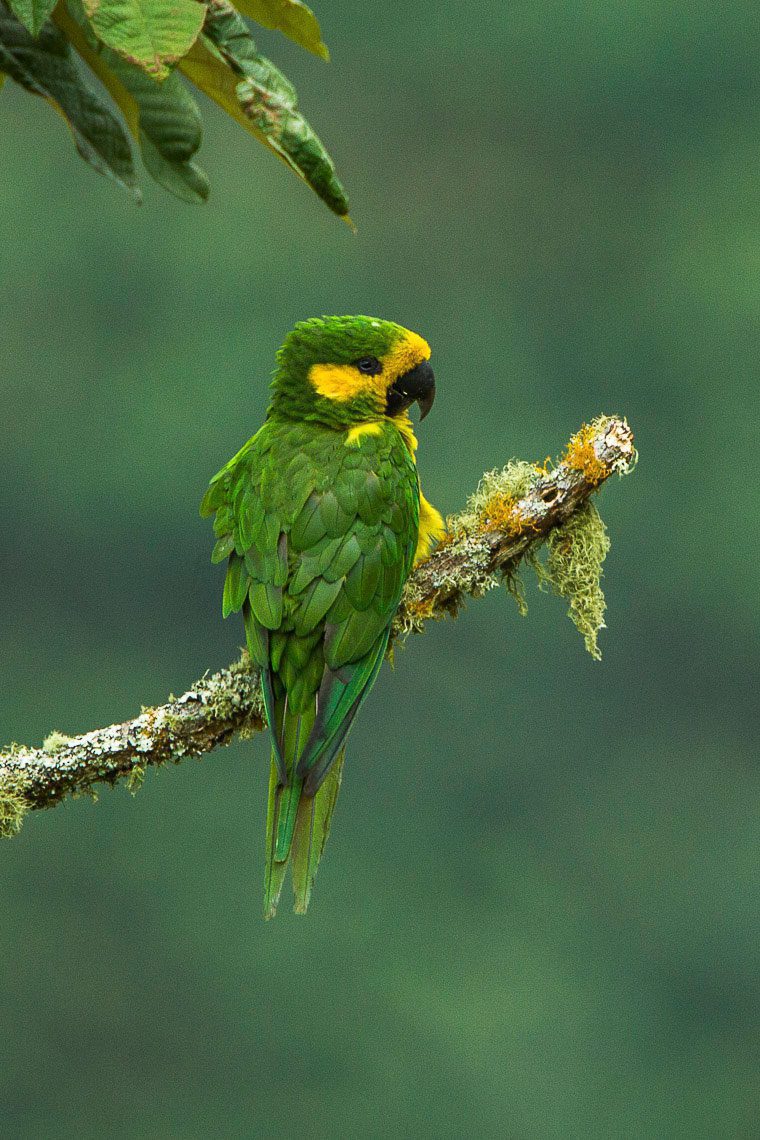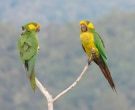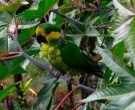Content |
|---|
Description:
42 cm.. of length and a weight of 285 g..
The Yellow-eared Parrot or Yellow-eared Parrot (Ognorhynchus icterotis) is a parrot of medium-sized; has the crown green grass with Emerald suffusion; the forecrown with a wide yellow stripe that extends to the lores, upper cheeks and below the eyes up to the ear-coverts; bottom of the cheeks and both sides of the neck green.
The upperparts, upperwing-coverts and flight feather are green grass. Under the wings yellowish green in coverts, yellowish in the flight feather. The underparts yellowish with increasingly darker green dye in the belly, the the thighs and area of the vent.
Upper, the tail green; down off red. The head is large in proportion to the body, with bill thick, blackish. Orbital ring, pale grey; Orange the irises; legs grey.
Both sexes similar.
The immature not described.
- Sound of the HTTPS://www.mascotarios.org/wp-content/themes/generatepress_child/sonidos/Yellow-eared Parrot.mp3.
Habitat:
Video – "Yellow-eared Parrot" (Ognorhynchus icterotis) |
|---|
They inhabit in the humid montane forests in the subtropical high and low temperate zones, sometimes frequent partially cleared areas.
Associated to the wax Palms (Ceroxylon quindiuense), Although the dependence of these species is uncertain since the birds remain absent from those areas in which these palms are abundant. Move, generally, in pairs or small flocks and perform migrations altitudinal and latitudinal, not specified, outside the breeding season.
Reproduction:
They fly in stable couples and they always nest in old nests.
There are reports of nests on wax Palms (Ceroxylon quindiuense) to 25 metres in height
child in the month of may in the North of Tolima and conditions of reproductive birds have been seen in the month of March in Huila. Breeding season July to October in Ecuador.
One of the most unique behaviors in reproduction of the Yellow-eared Parrot is the assistance of a third adult ave sharing the duties of parents, known as “brood helpers”, they have been observed assisting parents in parenting, feeding and caring for the chicks.
Clutch of four eggs.
Food:
It is known that they feed on las Palmas Ceroxylon quindiuense and Ceroxylon alpinum but it probably takes fruits of all other species of this genus; other reported foods include fruits of the Saurauia tomentosa and Sapium.
The Yellow-eared Parrot they sometimes feed in more open areas, returning the forest to rest.
Distribution:
Size of its range (breeding/resident): 168.000 km2
Its distribution is discontinuous.
Limited to the North of the Andes, in the North of Ecuador and West Colombito between 1.200 and 3.400 meters above sea level, (mostly between 2,500-3,000 m).
With distributed (or distributed) in the three chains of the Andes in Colombia; records in the West of the Andes, from a small area in the South, to the North of Cauca and possibly Valle del Cauca; in the Central Andes, from the western slope of Antioquia, Caldas and Cauca and in the eastern slope, in Tolima and Huila; in the East of the Andes from the West side and the East of the basin in Norte de Santander, on the eastern slope of Cundinamarca and in the header of the Magdalena River Valley, in Huila.
Observed to the North of Ecuador, from Carchi, Imbabura and Pichincha.
It is likely that they led by seasonality, with the evidence that are present in Ecuador in the months of November and Colombia during the rest of the year.
Formerly considered common and in some places even abundant, but now is very scarce and local.
Drastic reduction of its population in the century 20 due to deforestation on a large scale on much of its distribution area and perhaps decrease of species of Quindio wax Palm.
Recent records sporadic and the species may now be confined in a few localities in Colombia, including the region of the Munchique national natural park (West of the Andes in Cauca), where some forests remain unchanged, at the front of the Magdalena River Valley, and in the Northwest of the Andes, in Ecuador.
Registered, sporadically, in several protected areas, including the Cueva de los Guácharos National Park, Colombia, and Book ecológica Cotacachi-Cayapas in Pichincha, Ecuador.
The total population of the Aratinga Orejigualda is very small and in danger of extinction.
Very rare in captivity and remaining birds could be at risk of capture. Appendix I. critical.
Conservation:
• Red List category of the UICN current: In danger of extinction
• Population trend: Growing
The current population It is thought that you understand 1.103 individuals. But, a maximum of only 212 individuals have bred in recent years (Fundación ProAves in litt., 2010), therefore, This figure is used for the current population of mature individuals. The rest of the population is assumed cautiously being too young to reproduce.
Due to the intensive action conservation of the population has grown from 81 to 1.103 individuals in 2009, of which 212 they are mature (Fundación ProAves in litt., 2010).
Threats:
– Its distribution area It seems to be strongly restricted by the expansion of exotic forests, Since only occurs in the native forest (CEIA et to the., 2009).
– It has been a considerable loss and fragmentation of habitat (90-93% of Montane forest in Colombia) throughout its area of distribution (Salaman et al the 1999b, Snyder et to the., 2000.); But, several significant areas of habitat are maintained within their historic range, which suggests additional causes of impairment (Krabbe 1998, PGW Salaman in litt., 1999).
– The mortality of the Quindio wax Palm (Ceroxylon quindiuense) It is accelerating and the logging in adjacent areas increases its susceptibility to disease (Krabbe 1998, Salaman et to the. 1999to, Salaman et to the. 1999b, PGW Salaman in litt., 1999).
– The Quindio wax Palm they are incredibly long-lived and slow growing (some more of 500 years of age) (Salaman 2001), and are being exploited unsustainably for use in the celebrations of the Domingo de Ramos within the range of the species.
– In Ecuador, their hunting was prolific as food source (Krabbe and Sornoza 1996, Salaman et to the., 1999b), and capture has had any impact on Colombia, Although the species is very difficult to keep in captivity (Salaman et to the. 1999b, Salaman 2001).
"Yellow-eared Parrot" in captivity:
In the news, the Yellow-eared Parrot It is not a bird to keep captive, but you run the risk of being easy prey for poachers, Since It shows no fear toward humans.
In May of the 2000, a nest It was looted to remove a fledgling and use it as pet. But, this practice is apparently not common.
Alternative names:
– Yellow-eared Parrot, Yellow eared Parrot, Yellow-eared Conure, Yellow-eared Parakeet (ingles).
– Conure à joues d’or, Perriche à joues d’or, Perruche à joues d’or (French).
– Gelbohrsittich, Gelbohr-Sittich (German).
– Papagaio-de-crista-amarela (Portuguese).
– Aratinga Orejigualda, Loro Amarillo, Loro Orejiamarillo (español).
– Loro orejiamarillo, Perico de páramo o Catarnica (Colombia).
– Loro caripero (Ecuador).
scientific classification:
– Order: Psittaciformes
– Family: Psittacidae
– Scientific name: Ognorhynchus icterotis
– Citation: (Massena & Souance, 1854)
– Protonimo: Conurus icterotis
Yellow-eared Parrot images:
Sources:
– Avibase
– Parrots of the World – Forshaw Joseph M
– Parrots A Guide to the Parrots of the World – Tony Juniper & Mike Parr
– Birdlife
– Photos:
(1) – Yellow-eared Parrot – Colombia_S4E5367 by Francesco Veronesi – Flickr
(2) – Yellow-eared Parrot In the Yellow-eared Parrot Reserve near Jardin, Colombia by Joseph Blowers – Flickr
(3) – YELLOW-EARED PARROT Immature by Bryant Olsen – Flickr
(4) – YELLOW-EARED PARROTS by Bryant Olsen – Flickr
(5) – Reserva Natural de las Aves Loro Orejiamarillo – ProAves
(6) – Ognorhynchus icterotis Syn: Psittacara icterotis By J. Davernes (biodiversitylibrary.org) [Public domain], via Wikimedia Commons
– Sounds: (Xeno-canto)







